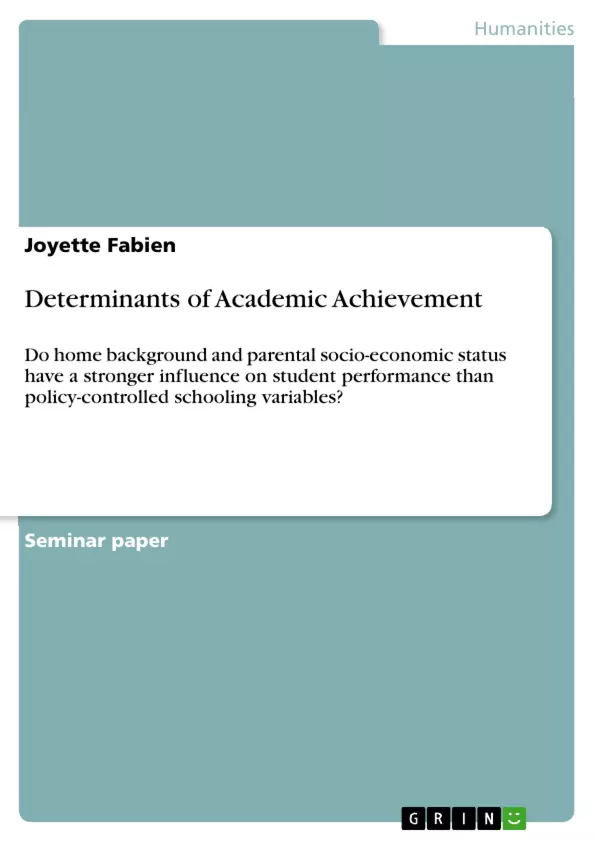‘The Determinants of Academic Achievement’ have been the subject of much discussion in the past and up to recent times. Extensive studies have been done and diverse conclusions have been reached. Earlier research was centered on developed countries, but recent times have seen an emphasis on developing countries and this has given rise to much controversy over the extent to which school and non-school factors influence academic achievement and the educational benefits of increasing expenditure on policy controlled schooling variables.
The observation has been made by Simmons and Alexander (1980) that home background or parental socio-economic status generally has a stronger influence on student performance at primary and lower secondary grades than the policy-controlled schooling variables. Their conclusions were drawn, in part, from a review of a number of studies conducted by the International Association for the Evaluation of Educational Achievement (IEA) in developed countries. Using the education production function (EPF) approach, Simmons and Alexander sought to equate the relative cost of school inputs to the relative value of outputs. Their conclusions have been variously supported, challenged or contradicted by previous and subsequent research carried out in the Third World.
The purpose of this study is to examine the validity of Simmons’ and Alexander’s conclusions through a comparative analysis of a sample of students from the 1990 Common Entrance Examination (CEE) intake of students of the Portsmouth Secondary School (P.S.S) in Dominica.
Inhaltsverzeichnis (Table of Contents)
- INTRODUCTION
- PART 1
- REVIEW OF LITERATURE ON THE DETERMINANTS OF ACADEMIC ACHIEVEMENT
- Non-School Factors
- School Factors
- Part 2
- THE STUDY.
- FINDINGS
- Part 3
- CONCLUSIONS
- RECOMMENDATIONS.
Zielsetzung und Themenschwerpunkte (Objectives and Key Themes)
This study aims to evaluate the validity of Simmons and Alexander's (1980) assertion that home background or parental socio-economic status exerts a stronger influence on student performance than policy-controlled schooling variables. The study focuses on a sample of students from the 1990 Common Entrance Examination (CEE) intake at the Portsmouth Secondary School (P.S.S) in Dominica.
- Impact of home background and parental socio-economic status on student performance.
- Influence of policy-controlled schooling variables on academic achievement.
- Comparative analysis of student performance in Dominica within the context of broader Caribbean research.
- Identification of factors specific to the Dominican context that influence educational outcomes.
- Emphasis on the need for further research on the Caribbean region.
Zusammenfassung der Kapitel (Chapter Summaries)
- Introduction: This chapter provides an overview of the existing research on the determinants of academic achievement, highlighting the debate surrounding the relative influence of school and non-school factors. It introduces Simmons and Alexander's (1980) observation and the purpose of the study, which is to examine the validity of their conclusions in the Dominican context.
- Part 1: Review of Literature on the Determinants of Academic Achievement: This section delves into the existing literature, exploring the various factors that contribute to academic achievement. It examines non-school factors such as family background, socioeconomic status, and environmental influences, as well as school factors such as teacher characteristics and school resources.
- Part 2: The Study and Findings: This section details the methodology and findings of the study. It outlines the data sources used, the specific student sample, and the key results obtained from the analysis.
Schlüsselwörter (Keywords)
The study focuses on the determinants of academic achievement, particularly in the context of developing countries. Key concepts include home background, parental socioeconomic status, policy-controlled schooling variables, educational production function (EPF), comparative analysis, Dominican context, and Caribbean region. The study also explores the impact of factors such as family size, family structure, and rural/urban residence on student performance.
- Quote paper
- Joyette Fabien (Author), 1991, Determinants of Academic Achievement, Munich, GRIN Verlag, https://www.grin.com/document/338844



